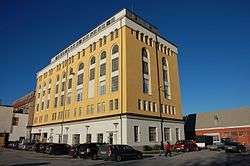Rjukan–Notodden Industrial Heritage Site
| Rjukan–Notodden Industrial Heritage Site | |
|---|---|
| Name as inscribed on the World Heritage List | |
 | |
| Type | Cultural |
| Criteria | ii, iv |
| Reference | 1486 |
| UNESCO region | Europe and North America |
| Inscription history | |
| Inscription | 2015 (39th Session) |
Rjukan–Notodden Industrial Heritage Site is a World Heritage Site in Telemark county, Norway, created to protect the industrial landscape around Lake Heddalsvatnet and Vestfjorddalen Walley. The landscape is centered on the plant built by the Norsk Hydro to produce fertilizer from atmospheric nitrogen. The complex also includes hydroelectric power plants, transport systems, including railways, transmission lines and factories, and workers' accommodation and social institutions in the towns of Notodden and Rjukan.[1]
The site was placed on the tentative World Heritage list on 19 June 2009 together with the Odda–Tyssedal Industrial Heritage Site.[2] On 5 July 2015 it was placed on the World Heritage list,[1] under Criteria II and IV, with following description of the Outstanding Universal Value:
Located in a dramatic landscape of mountains, waterfalls and river valleys, the site comprises hydroelectric power plants, transmission lines, factories, transport systems and towns. The complex was established by the Norsk-Hydro Company to manufacture artificial fertilizer from nitrogen in the air. It was built to meet the Western world’s growing demand for agricultural production in the early 20th century. The company towns of Rjukan and Notodden show workers’ accommodation and social institutions linked by rail and ferry to ports where the fertilizer was loaded. The Rjukan-Notodden site manifests an exceptional combination of industrial assets and themes associated to the natural landscape. It stands out as an example of a new global industry in the early 20th century.
History
In the 1900s, Norway experienced rapid industrial development through the availability of cheap hydroelectric power. Kristian Birkeland developed a method to extract nitrogen from the air, which, after an initial trial in Notodden in 1907, looked superior to existing technologies. Nitrogen was needed to produce fertilizers. Norsk Hydro was founded in 1905, and industrial development began in the Eastern Telemark region, previously an underdeveloped and underpopulated agricultural area. To produce fertilizers, it was essential to build factories, power stations, infrastructure for workers, as well as facilities for exporting the production. The fertilizers, artificial saltpetre, eventually surpasses the Chilean naturally mined saltpeter, at the time the most widely used fertilizer.[2]
At the beginning of construction, in 1907, the power was provided by the Svelgfoss Hydroelectric Power Station, which at the time was the largest in Europe and the second larges at the world.[2] The station is still in operation. Subsequently, two more station were built. Vemork, built on a waterfall near Rjukan, in 1911 was the largest power station in the world. A plant producing heavy water and most famous for the 1943 sabotage events (Operation Gunnerside) was built nearby. The original building of the station has been destroyed, but the station is in operation.[2][3] Another power plant, Såheim Hydroelectric Power Station, started operation in Rjukan in 1915. The building survived but the station operates elsewhere.[2]
One of the 36 towers of the saltpetre factory's towerhouse, which was in operation between 1911 and the 1980s, has been conserved and is protected as a cultural monument.[2]
In 1925, 80% of all apartments in Rjukan (1230 in total) were controlled by the Norsk Hydro. Red brick apartment buildings dominated, others were houses with individual gardens.[2]
References
- 1 2 "Rjukan–Notodden Industrial Heritage Site". UNESCO. 5 July 2015. Retrieved 5 July 2015.
- 1 2 3 4 5 6 7 "Rjukan/Notodden and Odda/Tyssedal Industrial Heritage Sites, Hydro Electrical Powered Heavy Industries with associated Urban Settlements (Company Towns) and Transportation System". UNESCO. Retrieved 5 July 2015.
- ↑ "Hydro's origins have become a World Heritage Site". Norsk Hydro. 5 July 2015. Retrieved 6 July 2015.
Coordinates: 59°52′43″N 8°35′37″E / 59.87861°N 8.59361°E